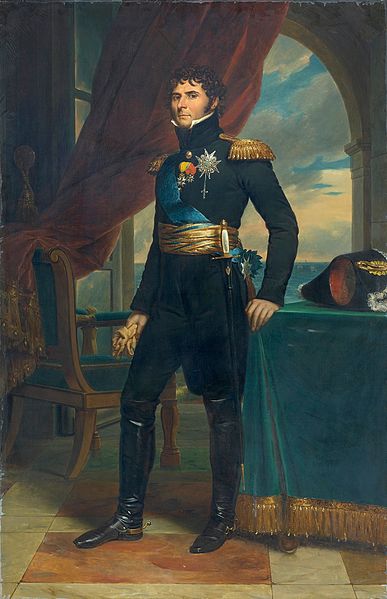A very long time ago, a young Frenchman came to South India to fight an American war and became a British prisoner. He would one day be appointed king of Sweden. Before confusing you any further, let me tell you how it all happened.
In 1775 the Thirteen American Colonies, controlled by the British, declared independence, calling themselves for the first time, the United States of America. The British did not want to let go of course, and the American War of Independence began. By 1778 France had entered the fray, supporting the Americans. The war lasted for about 8 years and its repercussions were felt in British and French Colonies around the world.
One of these repercussions was the 1783 Siege of Cuddalore, in present day Tamil Nadu in India. Here, at the French controlled Fort St. David and the adjoining sea, bloody battles for control were fought. In one of these fights, the French under the command of Sergeant Jean Baptiste Bernadotte, raided the British camp. Bernadotte was wounded and captured by the British, commanded by Colonel Christoph von Wangenheim, from Hanover in Germany.
Wangenheim took a liking to the young Frenchman, and showed him great kindness. They became friends. The siege continued for five days, after which, both men returned to their home countries. Two decades later they would meet again. Bernadotte did quite well, eventually becoming Marshall of the French Army. He was an excellent leader. As luck would have it, his king, Napoleon, decided to conquer Germany in 1804 and made Bernadotte military governor in Hanover. Bernadotte took the opportunity to seek out his old friend from his Indian exploits, Wangenheim. He thanked him profusely and both, were quite overjoyed to meet again.

Wangenheim’s kindness to Bernadotte, appears to have had more far reaching consequences than their friendship. In 1806, Bernadotte part lead the French charge against the Prussians supported by the Swedes, in the Battle of Lübeck, again in Germany. The French won and the troupes went on a rampage in the city, looting and destroying all they could. Bernadotte tried his very best to stop the madness. He also successfully protected the defeated Swedish soldiers, treated them with respect and let them return home. He paid forward what he had received almost 23 years ago in Cuddalore.
Commanding the Swedes that day, was Baron Gustav Mörner, who returned home marvellously impressed by Bernadotte’s fairness. By 1810 the king of Sweden, Charles XIII was sick and heirless. Sweden needed a crown prince soon and would have to look outside the country for one. Baron Karl Otto Mörner settled matters by convincing the council to elect Bernadotte to the position. He was Baron Gustav Mörner’s son and remembered what Bernadotte had done for his father.
History was being made: It wasn’t exactly normal to elect foreigners to the throne. Elections weren’t normal. period. Bernadotte a French subject, approached his king, Emperor Napoleon for his permission. Napoleon cleverly tried to extract a final promise: Bernadotte, as Swedish king, must never oppose Napoleon. Bernadotte true to his character, refused. Napoleon yielded, saying “Go, and let our destinies be accomplished”. And so, in 1818, by destiny driven by a little human kindness, Bernadotte became King Charles XIV John of Sweden.
For most of his reign, he was a respected and popular monarch. The present King of Sweden belongs to the House of Bernadotte, one of the oldest surviving Royal Houses of Europe today!
To hear other tales from the annals of history, join us on one of our walking tours.
You can also download the Storytrails App and discover a city all by yourself through our location aware Audio Tours.
Archives
- January 2022
- December 2021
- November 2021
- August 2021
- March 2021
- February 2021
- January 2021
- December 2020
- November 2020
- October 2020
- September 2020
- August 2020
- April 2020
- March 2020
- February 2020
- January 2020
- November 2019
- October 2019
- September 2019
- August 2019
- July 2019
- June 2019
- August 2017
- February 2017
- January 2017
- October 2013
Featured Posts
- Tales that pots tell: Keeladi excavations AUGUST 18, 2021
- The Last Grand Nawab: Wallajah FEBRUARY 10, 2021
- How Tej Singh became Raja Desingu of Gingee FEBRUARY 5, 2021
- How Shahjahan seized the Mughal throne JANUARY 28, 2021
- Alai Darwaza – Qutub Minar Complex, Delhi NOVEMBER 21, 2020
- Marking History through British buildings NOVEMBER 17, 2020
- The last great queen of Travancore NOVEMBER 7, 2020
- Brahmi and the evolution of scripts OCTOBER 15, 2020
- The Cambodian King of Kanchipuram OCTOBER 14, 2020
- James Prinsep – the man who read the writing on the wall OCTOBER 10, 2020
- Mariamman – the Village Goddess who travelled SEPTEMBER 30, 2020
- Misnamed Monuments of Mamallapuram SEPTEMBER 28, 2020








